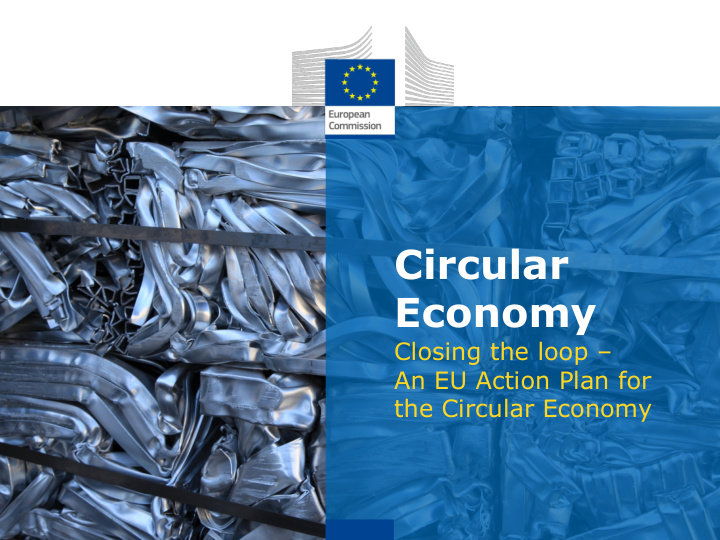



Circular Economy Closing the loop – An EU Action Plan for the Circular Economy
Circular Economy: an EU priority Jobs, Protecting Growth and the environment Investment and boosting competitiveness Democratic Energy Union Change, and Climate go hand-in-hand: Better Regulation both are about building a sustainable CIRCULAR ECONOMY future.
Creating jobs and boosting GDP Achieve higher levels of economic productivity through diversification, technological upgrading and innovation, including through a focus on high-value added and labour-intensive sectors Improve progressively, through 2030, global resource efficiency in consumption and production and endeavour to decouple economic growth from environmental degradation , in accordance with the 10- year framework of programmes on sustainable consumption and production, with developed countries taking the lead 4
Improving environmental quality for citizens Increase water-use efficiency to address water scarcity. Reduce pollution, halving the proportion of untreated wastewater and substantially increasing recycling and safe reuse globally By 2025, prevent and significantly reduce marine pollution of all kinds, in particular from land-based activities, including marine debris and nutrient pollution Deforestation and desertification – caused by human activities and climate change – pose major challenges to sustainable development and have affected the lives and livelihoods of millions of people in the fight against poverty. 5
Ensuring responsible consumption and production patterns Promote resource and energy efficiency , sustainable infrastructure , and providing access to basic services, green and decent jobs and a better quality of life for all. Achieve the environmentally sound management of chemicals and all wastes throughout their life cycle and significantly reduce their release to air, water and soil in order to minimize their adverse impacts on human health and the environment 6
4 Key areas of action 5 Priority sectors Construction & Demolition
Production and Products • Embed circularity in the design of new products and the materials they are made of • Deal with current and future materials which are not circular
Consumption • Helping consumers and public authorities choose sustainable products and services • Providing reliable, standardised and comparable information to enable optimisation of policy and investment decisions
Waste Management • Guided by SDG 12, stipulating that by 2020 we should : è achieve the environmentally sound management of chemicals and all wastes throughout their life cycle è significantly reduce their release to air, water and soil in order to minimize their adverse impacts on human health and the environment.
Secondary Raw Materials • Better understanding of the uses of recycled materials • Clearer definition of the requirements they have to meet in order to be reprocessed into secondary raw materials that are è of comparable quality to virgin materials and è can replace them at a reasonable cost and with the lowest possible use of resources (energy, water, etc.).
Implementation since December 2015…
Ecodesign Working Plan 2016-2019 BREFs - industrial sectors EMAS – EU Ecolabel Refit False Green Claims – On-line sales of goods Legislative proposals on waste Revised fertilisers regulation Guidance for water planning
EU Platform on Food Losses and Food Waste Contribution EU Bioeconomy Strategy to the circular economy Report on critical raw materials and the circular economy Pre-demolition audits Recycling protocol CDW Level(s)- sustainable buildings 14
CE Finance Support platform Supporting the generation and financing of circular economy projects Pillar I Pillar II Pillar III Coordination Advisory Financial Instruments and Services Awareness
2017- What's next? Plastics Strategy Interface product-chemical-waste legislation Monitoring Framework Legislative proposal to promote water reuse European Circular Economy Stakeholder Platform 16
Plastics Strategy
Objectives • Reduce plastic leakage in the environment • Exploit the full potential of plastic recycling and uptake of recyclates Ø Stimulate research, innovation & investments Ø Take up the international challenge
Interface Product-Chemical and Waste Legislations 4 obstacles Increase safety , facilitate recycling and improve the trust in secondary raw Insufficient information • materials about substances of concern Presence of substances of • concern in recycled materials Uncertainties about how • materials can cease to be waste Difficulties in applying EU • waste classification
Monitoring Framework Assess the progress towards CE in the EU and its MSs Existing data from Eurostat and in cooperation with EEA Building on Resource Efficiency Scoreboard and Raw Material Scoreboard
EU-wide minimum requirements for urban waste water reuse for agriculture irrigation * Encourage efficient, safe and cost-effective water re-use * Increase the recycling of nutrients contained in waste water in agriculture * Contribute to growth and jobs creation by stimulating innovative technologies and water infrastructure
European Circular Economy Stakeholder Platform Network of networks- Open Platform Next steps: I. Policy dialogue with stakeholders' input: Ø best practices Ø national, regional, local strategies Ø policy statements and commitments I. Coordination Group for circular economy- related networks-call for expressions of interest- 192 applications II. http://circulareconomy.europa.eu/platform/ 22
More to come in 2018 ? • Options for a more sustainable Product Policy Framework • Follow up to the Product/Organisational Environmental Footprint
Learn more about the Circular Economy http://ec.europa.eu/environment/ circular-economy/index_en.htm 24
Recommend
More recommend